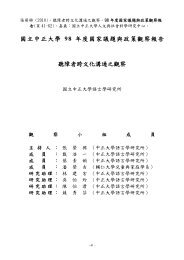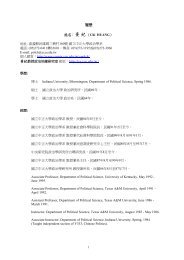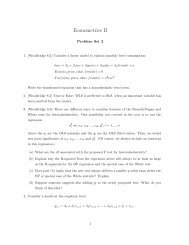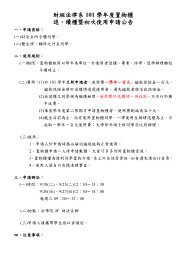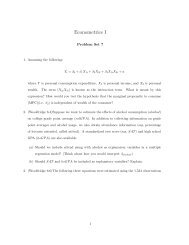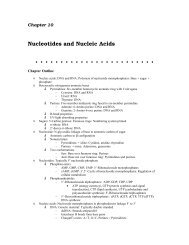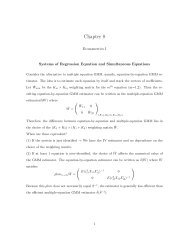Microeconometrics: Homework 1
Microeconometrics: Homework 1
Microeconometrics: Homework 1
Create successful ePaper yourself
Turn your PDF publications into a flip-book with our unique Google optimized e-Paper software.
<strong>Microeconometrics</strong>: <strong>Homework</strong> 1<br />
2010<br />
1. Problem 5.1. In this problem you are to establish the algebraic equivalence between<br />
2SLS and OLS estimation of an equation containing an additional regressor. Although<br />
the result is completely general, for simplicity consider a model with a single (suspected)<br />
endogenous variable:<br />
y 1 = z 1 δ 1 + α 1 y 2 + u 1<br />
y 2 = zπ 2 + v 2<br />
For notational clarity, we use y 2 as the suspected endogenous variable and z as the vector<br />
of all exogenous variables. The second equation is the reduced form for y 2 . Assume that<br />
z has at least one more element than z 1 .<br />
We know that one estimator of (δ 1 , α 1 ) is the 2SLS estimator using instruments x.<br />
Consider an alternative estimator of (δ 1 , α 1 ): (a) estimate the reduced form by OLS,<br />
and save the residuals ˆv 2 ; (b) estimate the following equation by OLS:<br />
y 1 = z 1 δ 1 + α 1 y 2 + ρ 1ˆv 2 + error (5.52)<br />
Show that the OLS estimates of δ 1 and α 1 from this regression are identical to the<br />
2SLS estimators. [Hint: Use the partitioned regression algebra of OLS. In particular, if<br />
ŷ = x 1 ˆβ1 + x 2 ˆβ2 is an OLS regression, ˆβ 1 can be obtained by first regressing x 1 on x 2 ,<br />
getting the residuals, say ẍ 1 , and then regressing y on ẍ 1 ; see, for example, Davidson<br />
and MacKinnon (1993, Section 1.4).<br />
You must also use the fact that z 1 and ˆν 2 are<br />
orthogonal in the sample.]<br />
1
Sol: Define x 1 ≡ (z 1 , y 2 ) and x 1 ≡ ˆv 2 , and let ˆβ ≡ ( ˆβ ′ 1 , ˆρ 1) ′ be OLS estimator from<br />
(5.52), where ˆβ 1 = (ˆδ ′ 1 , ˆα 1) ′ . Using the hint, ˆβ1 can also be obtained by partitioned<br />
regression:<br />
(i) Regress x 1 onto ˆv 2 and save the residuals, say ẍ 1 .<br />
(ii) Regress y 1 onto ẍ 1 .<br />
But when we regress z 1 onto ˆv 2 , the residuals are just z 1 since ˆv 2 is orthogonal in sample<br />
to z. (More precisely, ∑ N<br />
i=1 z′ i1ˆv i2 = 0.) Further, because we can write y 2 = ŷ 2 + ˆv 2 ,<br />
where ŷ 2 and ˆv 2 are orthogonal in sample, the residuals from regressing y 2 onto ˆv 2 are<br />
simply the first stage fitted values, ŷ 2 . In other words, ẍ 1 = (z 1 , ŷ 2 ). But the 2SLS<br />
estimator of β 1 is obtained exactly from the OLS regression y 1 on z 1 , ŷ 2 .<br />
2. Problem 5.5. One occasionally sees the following reasoning used in applied work for<br />
choosing instrumental variables in the context of omitted variables. The model is<br />
y 1 = z 1 δ 1 + α 1 y 2 + γq + a 1<br />
where q is the omitted factor. We assume that a 1 satisfies the structural error assumption<br />
E(a 1 |z 1 , y 2 , q) = 0, that z 1 is exogenous in the sense that E(q|z 1 ) = 0, but that y 2 and<br />
q may be correlated. Let z 2 be a vector of instrumental variable candidates for y 2 .<br />
Suppose it is known that z 2 appears in the linear projection of y 2 onto (z 1 , z 2 ), and so<br />
the requirement that z 2 be partially correlated with y 2 is satisfied. Also, we are willing<br />
to assume that z 2 is redundant in the structural equation, so that a 1 is uncorrelated<br />
with z 2 . What we are unsure of is whether z 2 is correlated with the omitted variable q,<br />
in which case z 2 would not contain valid IVs.<br />
To test whether z 2 is in fact uncorrelated with q, it has been suggested to use OLS on<br />
the equation<br />
y 1 = z 1 δ 1 + α 1 y 2 + z 2 ψ 1 + u 1 (5.55)<br />
where u 1 = γq + a 1 , and test H 0 : ψ 1 = 0. Why does this method not work<br />
Sol: Under the null hypothesis that q and z 2 are uncorrelated, z 1 and z 2 are exoge-<br />
2
nous in (5.55) because each is uncorrelated with u 1 , and so the regression of y 1 on<br />
z 1 , y 2 , z 2 does not produce a consistent estimator of 0 on z 2 even when E(z 2 ′ q) = 0. We<br />
could find that ˆψ 1 from this regression is statistically different from zero even when q<br />
and z 2 are uncorrelated–in which case we could incorrectly conclude that z 2 is not a valid<br />
IV candidate. Or, we might fail to reject H 0 : ψ 1 = 0 when z 2 and q are correlated–in<br />
which case we incorrectly conclude that the elements in z 2 are valid as instruments.<br />
The point of this exercise is that one cannot simply add instrumental variable candidates<br />
in the structural equation and then test for significance of these variables using OLS.<br />
This is the sense in which identification cannot be tested. With a single endogenous<br />
variable, we must take a stand that at least one element of z 2 is uncorrelated with q.<br />
3. Problem 10.3. For T = 2 consider the standard unobserved effects model<br />
y it = x it β + c i + u it , t = 1, 2<br />
Let ˆβ F E and ˆβ F D denote the fixed effects and first difference estimators, respectively.<br />
a. Show that the FE and FD estimates are numerically identical.<br />
b. Show that the error variance estimates from the FE and FD methods are numerically<br />
identical.<br />
Sol:<br />
a. Let ¯x i = (x i1 + x i2 )/2, ȳ i = (y i1 + y i2 )/2, ẍ i1 = x i1 − ¯x i , ẍ i2 = x i2 − ¯x i , and similarly<br />
for ÿ i1 and ÿ i2 . For T = 2 the fixed effects estimator can be written as<br />
[<br />
∑ N ] −1 [<br />
∑ N ]<br />
ˆβ F E = (ẍ ′ i1ẍ i1 + ẍ ′ i2ẍ i2 ) (ẍ ′ i1ÿ i1 + ẍ ′ i2ÿ i2 )<br />
Now, by simple algebra,<br />
i=1<br />
i=1<br />
ẍ i1 = (x i1 − x i2 )/2 = −∆x i /2<br />
ẍ i2 = (x i2 − x i1 )/2 = ∆x i /2<br />
ÿ i1 = (y i1 − y i2 )/2 = −∆y i /2<br />
ÿ i2 = (y i2 − y i1 )/2 = ∆y i /2<br />
3
Therefore,<br />
ẍ ′ i1ẍ i1 + ẍ ′ i2ẍ i2 = ∆x ′ i∆x i /4 + ∆x ′ i∆x i /4 = ∆x ′ i∆x i /2<br />
ẍ ′ i1ÿ i1 + ẍ ′ i2ÿ i2 = ∆x ′ i∆y i /4 + ∆x ′ i∆y i /4 = ∆x ′ i∆y i /2<br />
and so<br />
[<br />
∑ N<br />
ˆβ F E =<br />
i=1<br />
] −1 [<br />
∑ N<br />
∆x ′ i∆x i /2<br />
i=1<br />
]<br />
∆x ′ i∆y i /2<br />
[<br />
∑ N ] −1 [<br />
∑ N ]<br />
= ∆x ′ i∆x i ∆x ′ i∆y i = ˆβ F D .<br />
i=1<br />
b. Let û i1 = ÿ i1 − ẍ i1 ˆβF E and û i2 = ÿ i2 − ẍ i2 ˆβF E be the fixed effects residuals for<br />
the two time periods for cross section observation i. Since ˆβ F E = ˆβ F D , and using the<br />
representations in (4.1 ′ ), we have<br />
i=1<br />
û i1 = −∆y i /2 − (−∆x i /2) ˆβ F D = −(∆y i − ∆x i ˆβF D )/2 ≡ −ê i /2<br />
û i2 = ∆y i /2 − (∆x i /2) ˆβ F D = (∆y i − ∆x i ˆβF D )/2 ≡ ê i /2<br />
where ê i ≡ ∆y i − ∆x i ˆβF D are the first difference residuals, i = 1, 2, . . . , N.<br />
Therefore,<br />
N∑<br />
N∑<br />
(û 2 i1 + û 2 i2) = (1/2)<br />
i=1<br />
i=1<br />
This shows that the sum of squared residuals from the fixed effects regression is exactly<br />
ê 2 i<br />
one have the sum of squared residuals from the first difference regression.<br />
Since we<br />
know the variance estimate for fixed effects is the SSR divided by N − K(when T = 2),<br />
and the variance estimate for first difference is the SSR divided by N − K, the error<br />
variance from fixed effects is always half the size as the error variance for first difference<br />
estimation, that is, ˆσ u 2 = ˆσ e/2 2 (contrary to what the problem asks you so show). What I<br />
wanted you to show is that the variance matrix estimates of ˆβ F E and ˆβ F D are identical.<br />
4
This is easy since the variance matrix estimate for fixed effects is<br />
ˆσ 2 u<br />
[<br />
∑ N −1 [<br />
∑ N −1 [<br />
∑ N ] −1<br />
(ẍ ′ i1ẍ i1 + ẍ ′ i2ẍ i2 )]<br />
= (ˆσ e/2)<br />
2 ∆x ′ i∆x i /2]<br />
= ˆσ e<br />
2 ∆x ′ i∆x i ,<br />
i=1<br />
i=1<br />
i=1<br />
which is the variance matrix estimator for first difference. Thus, the standard errors,<br />
and in fact all other test statistics (F statistics) will be numerically identical using the<br />
two approaches.<br />
4. Problem 10.5. Assume that Assumptions RE.1 and RE.3a hold, but V ar(c i |x i ) ≠<br />
V ar(c i ).<br />
a. Describe the general nature of E(v i v i ′ |x i).<br />
b. What are the asymptotic properties of the random effects estimator and the associated<br />
test statistics How should the random effects statistics be modified<br />
Sol:<br />
a. Write v i v i ′ = c2 i j T j<br />
T ′ + u iu ′ i + j T (c i u ′ i ) + (c iu i )j<br />
T ′ ). Under RE.1, E(u i|x i , c i ) = 0, which<br />
implies that E[(c i u ′ i )|x i] = 0 by iterated expectations.<br />
Under RE.3a, E(u i u ′ i |x i, c i ) = σuI 2 T , which implies that E(u i u ′ i |x i) = σuI 2 T (again, by<br />
iterated expectations). Therefore,<br />
E(v i v ′ i|x i ) = E(c 2 i |x i )j T j ′ T + E(u i u ′ i|x i ) = h(x i )j T j ′ T + σ 2 uI T ,<br />
where h(x i ) ≡ V ar(c i |x i ) = E(c 2 i |x i)(by RE.1b). This shows that the conditional variance<br />
matrix of v i given x i has the same covariance for all t ≠ s, h(x i ), and the same<br />
variance for all t, h(x i ) + σu. 2 Therefore, while the variances and covariances depend on<br />
x i in general, they do not depend on time separately.<br />
b. The RE estimator is still consistent and √ N−asymptotically normal without assumption<br />
RE.3b, but the usual random effects variance estimator of ˆβ RE is no longer<br />
valid because E(v i v i ′ |x i) does not have the form (10.30)(because it depends on x i ). The<br />
robust variance matrix estimator given in (7.49) should be used in obtaining standard<br />
errors or Wald statistics.<br />
5




